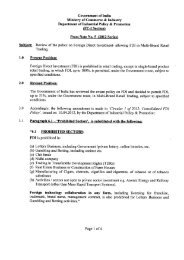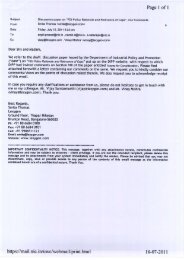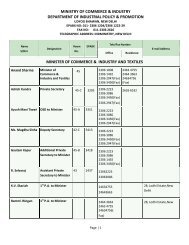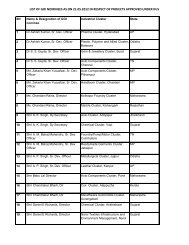fdi in india and its growth linkages - Department Of Industrial Policy ...
fdi in india and its growth linkages - Department Of Industrial Policy ...
fdi in india and its growth linkages - Department Of Industrial Policy ...
Create successful ePaper yourself
Turn your PDF publications into a flip-book with our unique Google optimized e-Paper software.
FDI IN INDIA AND ITS GROWTH LINKAGES<br />
While firms are generally headquartered <strong>in</strong> relatively large cities, the plants are located <strong>in</strong> large as well as small<br />
(Class-3) cities.<br />
While <strong>in</strong>vestors <strong>in</strong> <strong>in</strong>dustrial plants may not follow a highly structured theory-based model with regard to the choice of<br />
a particular location, there would be some rule-of-thumb considerations for these decisions. Multiple factors are likely<br />
to play a simultaneous role <strong>in</strong> when a firm makes a decision on where to locate a plant. The decision would be based<br />
primarily on the nature of the plant. For example, an <strong>in</strong>tegrated iron <strong>and</strong> steel plant would prefer to locate close to<br />
regions produc<strong>in</strong>g primary <strong>in</strong>puts (iron ore <strong>and</strong> coal), whereas a cement plant would be close to limestone quarries.<br />
State-level factors may <strong>in</strong>clude the number of SEZs, energy deficit, per capita <strong>in</strong>come, <strong>and</strong> the number of workers’<br />
unions. City-level factors may <strong>in</strong>clude congestion <strong>in</strong> a city, presence of a port/ airport/ SEZ, distance from the nearest<br />
major city, <strong>and</strong> the share of FDI plants <strong>in</strong> total plants, among others. The share of FDI plants <strong>in</strong> the total number of<br />
plants <strong>in</strong> a city may be taken as a proxy for FDI plant density/ FDI agglomeration.<br />
The analysis is based on 1,240 plants located <strong>in</strong> 286 cities (21 Class-1, 20 Class-2 <strong>and</strong> 245 Class-3 cities) spread over<br />
26 states <strong>and</strong> Union Territories (Tables 6.52 <strong>and</strong> 6.53). These 1,240 plants account for 12 per cent of the total plants<br />
(FDI plus domestic) located <strong>in</strong> the correspond<strong>in</strong>g 286 cities <strong>and</strong> 26 states / Union Territories. <strong>Of</strong> the 1,240 FDI plants,<br />
434 plants are located <strong>in</strong> Class-1 cities, 85 <strong>in</strong> Class-2 cities <strong>and</strong> 721 <strong>in</strong> Class-3 cities. Thus, Class-3 cities account for<br />
58 per cent of the total number of FDI plants. With regard to regional distribution, there are 217 FDI plants <strong>in</strong> the<br />
north, 184 <strong>in</strong> the east, 481 <strong>in</strong> the west <strong>and</strong> 358 <strong>in</strong> the south (Table 6.54). In the northern region, about 79 per cent of<br />
the 217 FDI plants are located <strong>in</strong> Class-3 cities; the correspond<strong>in</strong>g numbers are 71 per cent <strong>in</strong> the east, 51 per cent <strong>in</strong><br />
the west <strong>and</strong> 49 per cent <strong>in</strong> the south.<br />
In the model estimation, we have divided city sizes as “large” for Class-1 <strong>and</strong> Class-2 cities taken together, <strong>and</strong> “small”<br />
for Class-3 cities. We have used a discrete choice b<strong>in</strong>ary logit econometric model to estimate locational decisions of<br />
FDI-enabled plants <strong>in</strong> India. 15 The discrete choice model facilitates our analysis to reveal the city-level preferences of<br />
FDI-enabled firms which might otherwise be lost <strong>in</strong> aggregate methodologies (Cheng, 2007). In the estimated<br />
regression equation, the dependent variable is set up as zero if a particular plant is located <strong>in</strong> a large city (Classes 1 <strong>and</strong><br />
2) <strong>and</strong> 1 if it is located <strong>in</strong> a small (Class-3) city.<br />
We worked with various alternative model specifications based on <strong>in</strong>dependent variables with firm-, city-, state-, <strong>and</strong><br />
region-specific characteristics. These characteristics relate to dummy, discrete, <strong>and</strong> cont<strong>in</strong>uous variables. In our f<strong>in</strong>al<br />
estimate, we <strong>in</strong>corporate the firm-level characteristic as export <strong>in</strong>tensity (cont<strong>in</strong>uous). The city-level characteristics<br />
<strong>in</strong>clude the share of FDI plants <strong>in</strong> total plants (cont<strong>in</strong>uous), airport location <strong>in</strong> a city (dummy variable) <strong>and</strong> the distance<br />
from the nearest Class-1 city (distance-wise dummies). The state-level variables <strong>in</strong>clude the number of SEZs (discrete),<br />
power deficit to availability ratio (cont<strong>in</strong>uous), number of trade unions (discrete) <strong>and</strong> per capita <strong>in</strong>come (cont<strong>in</strong>uous).<br />
Other <strong>in</strong>dependent variables refer to the four regions (dummies) as well as regional <strong>in</strong>teraction dummy variables vis-àvis<br />
distance dummies.<br />
It was found that the alternative specifications make some of the <strong>in</strong>dependent variables consistent <strong>in</strong> terms of sign <strong>and</strong><br />
significance, while other variables provide fragile results with respect to sign/ significance. Variables, such as the share of<br />
FDI plants <strong>in</strong> a city <strong>and</strong> electricity deficit to availability ratio <strong>in</strong> a state, are robust across various model specifications.<br />
One variable that showed less robust results is per capita <strong>in</strong>come. However, we <strong>in</strong>cluded this <strong>in</strong> the f<strong>in</strong>al specification of<br />
the model as a proxy for level of development of a state. Two specifications, one show<strong>in</strong>g the base estimate <strong>and</strong> other<br />
depict<strong>in</strong>g the f<strong>in</strong>al accepted specification, are shown <strong>in</strong> Table 6.55.<br />
15.Technical details of this model are provided <strong>in</strong> Long <strong>and</strong> Freeze (2003).<br />
70












